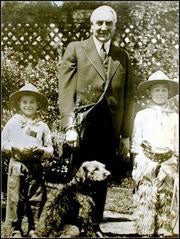 This week I thought it would be fun to start looking at some names of dogs that have some historical background.
This week I thought it would be fun to start looking at some names of dogs that have some historical background.
This week I chose the dog name:
Laddie Boy
Laddie Boy was the name of the Airedale that belonged to President Warren G. Harding, the 29th president of the United States from 1921 to 1923. Here are some fun and interesting facts about Laddie Boy and President Harding:
Laddie Boy (January 23, 1919 to 1929) was an Airedale terrier owned by US President Warren G. Harding and was a celebrity during the Harding administration.
Laddie boy had his own hand carved chair to sit in during cabinet meetings.
Laddie Boy, delivered President Harding’s newspaper each day.
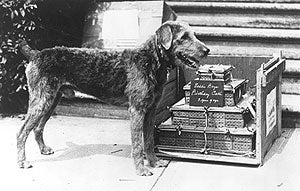 The white house held birthday parties for Laddie Boy, invited other neighborhood dogs to join, and served them a birthday party and a cake made of dog biscuits.
The white house held birthday parties for Laddie Boy, invited other neighborhood dogs to join, and served them a birthday party and a cake made of dog biscuits.
Newspapers published mock interviews with the dog.
Purportedly, the dog howled constantly the 3 days prior to the president’s death at the Palace Hotel in San Francisco, knowing of his master’s imminent demise.
In memorial of president Harding, newsboys collected 19,134 pennies to be remelted and sculpted into a statue of Laddie Boy.
Harding’s widow died before the statue was completed in 1927 and the statue was presented to the Smithsonian Institute where it currently resides today.
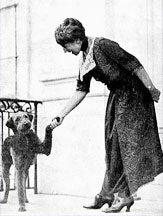 Some interesting facts about President Harding:
Some interesting facts about President Harding:
Harding was the first president to speak over the radio.
He was the first president to visit Canada. He stopped in Vancouver on his way to Alaska.
He was also the first president to visit Alaska.
Harding was the first president to ride to his inauguration in a car.
Warren G. Harding was the first president to have a public golf course named after him.
Out of all the presidents, Harding had the biggest feet. He wore size fourteen shoes.
Picture Credits:
1. President Harding with Laddie Boy and 2 children, Photo from The Library of Congress
2. Laddie Boy’s Birthday Cake. Description: President and Mrs. Harding’s dog, Laddie Boy, receives a birthday cake on his third birthday. Date: July 25, 1922. Creator: Herbert E. French, National Photo Company. Credit: Library of Congress.
3. Florence Harding and Laddie Boy. Photo from The Library of Congress
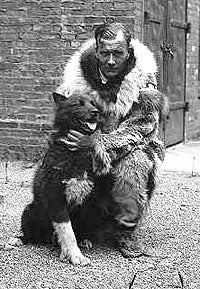 The dog name I chose to highlight this week is:
The dog name I chose to highlight this week is: 
















 The dog name I chose to highlight this week is:
The dog name I chose to highlight this week is:  This Week’s cool historical dog names is:
This Week’s cool historical dog names is: 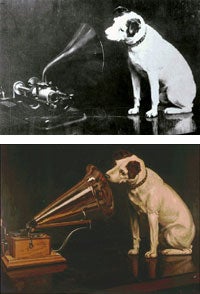 This week our Historical Dog Name is also a very unique dog name!
This week our Historical Dog Name is also a very unique dog name! 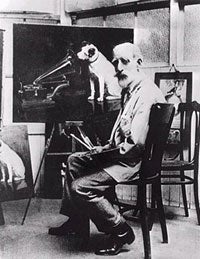 The painting took on several revisions and changes and the original Phonograph was changed to a Gramophone, but eventually it became the image we all know, and we all remember Nipper the dog!
The painting took on several revisions and changes and the original Phonograph was changed to a Gramophone, but eventually it became the image we all know, and we all remember Nipper the dog! This week I thought it would be fun to start looking at some names of dogs that have some historical background.
This week I thought it would be fun to start looking at some names of dogs that have some historical background.  The white house held birthday parties for Laddie Boy, invited other neighborhood dogs to join, and served them a birthday party and a cake made of dog biscuits.
The white house held birthday parties for Laddie Boy, invited other neighborhood dogs to join, and served them a birthday party and a cake made of dog biscuits.  Some interesting facts about President Harding:
Some interesting facts about President Harding: